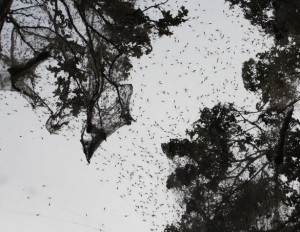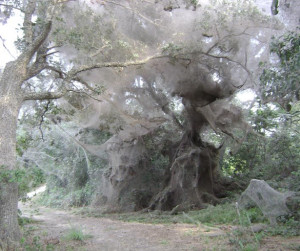A few years ago, some of you may remember, a park ranger at Lake Tawakoni State Park (about 50 miles east of Dallas, TX) reported a giant spider web built by an incredible number of spiders. The discovery was reported around the month before Halloween, so of course the media made a big deal of it and pictures and stories went viral around the world. The site attracted thousands of pilgrims, some from as far away as Europe. For a full account of the excitement, click here.
According to Mike Quinn, an entomologist who follows all of these sorts of happenings around the state, when National Geographic Society revisited the Lake Tawakoni site last month to do some filming, it was happening again. In addition, Texas Parks and Wildlife’s David Riskind reports that a site at Lake Somerville State Park near College Station appears to also be developing its own version of the spooky web.

Thousands of long-jawed orb weaver spiders starting a communal web at Lake Somerville State Park, June 2010. Image by Tommy Snow, courtesy Texas Parks and Wildlife Department.
Spiders aren’t really considered social, so what’s all this about? In the Lake Tawakoni event of 2007, experts concluded that a perfect storm of conditions came together to make the nest possible. For example a sizable emergence of aquatic midges apparently occurred nearby, providing food for the aggregation. Also, communal nest building among some spiders, especially the Tetragnathids (aka, long-jawed orb weavers), than previously recognized. Several other similar nests have been reported since the 2007 Tawakoni web. Regardless of whether you like or hate spiders, you have to respect what skill, patient diligence and the cooperation of a large number of individuals can accomplish. And if you don’t like spiders, I’d advise staying away from these two sites this summer.
